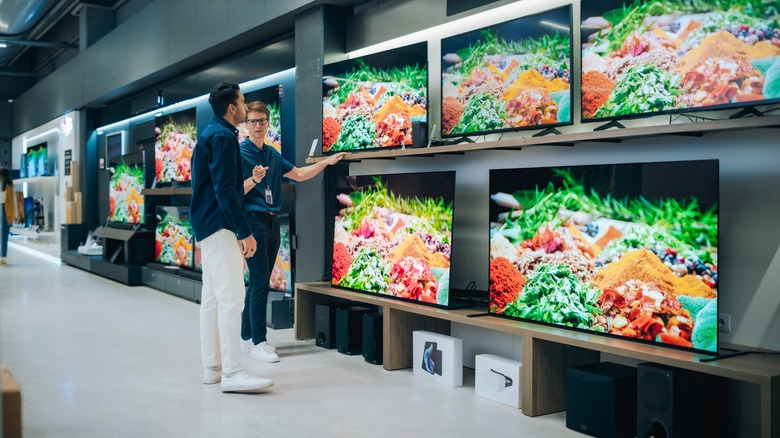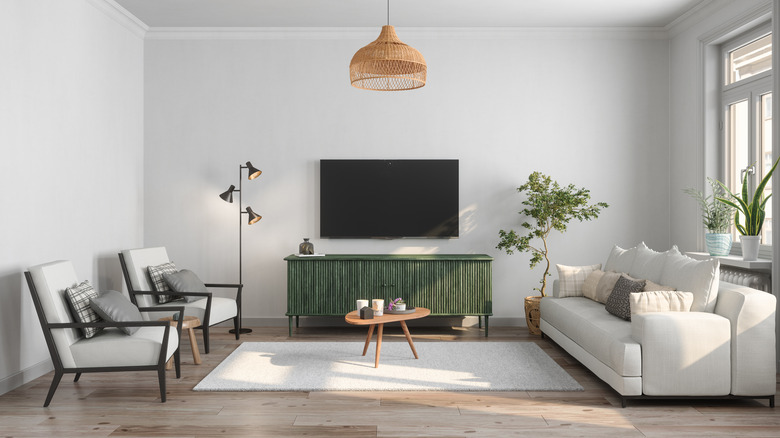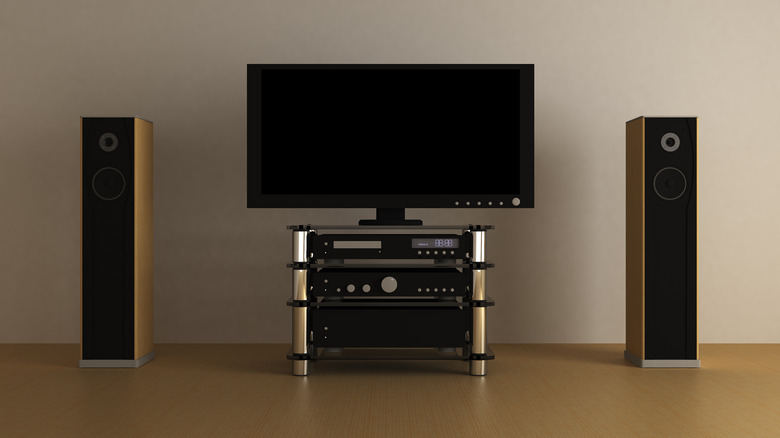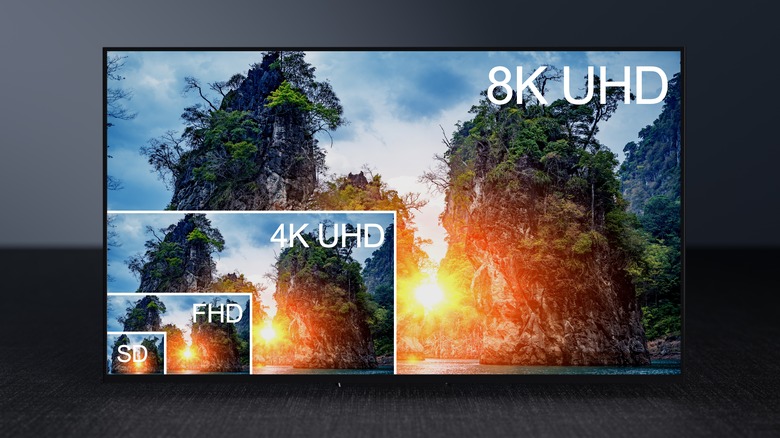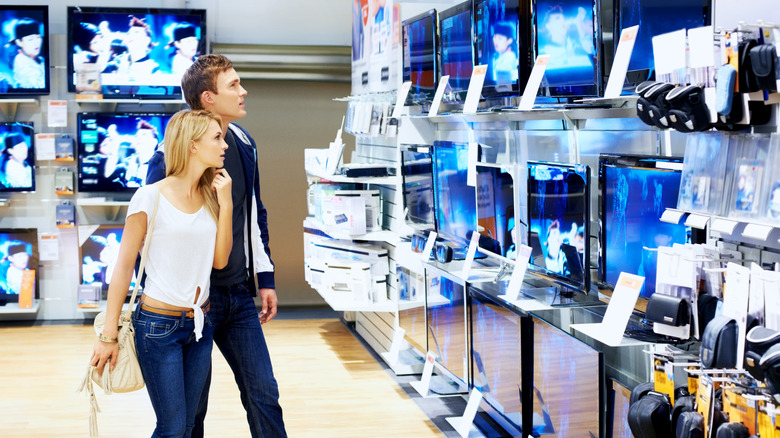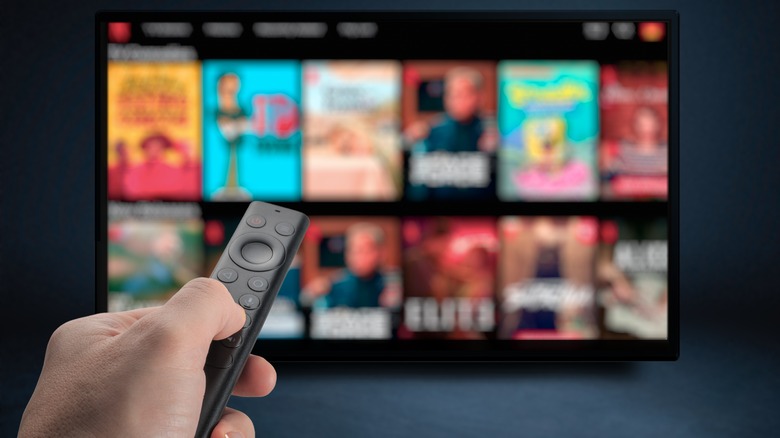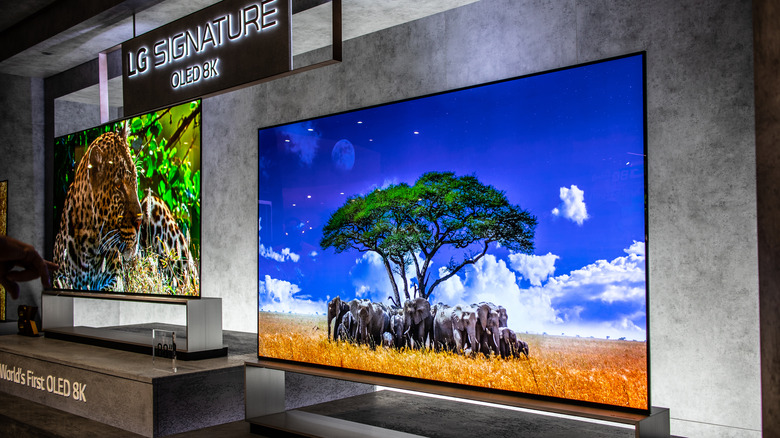11 Important Mistakes To Avoid When Buying A New TV
Guilty of binging "Shōgun" or "Ripley" deep into the evening hours lately? There's nothing to be ashamed about. Per Statista, most people watch at least 2 to 3 hours of television each day. This is in addition to spending about seven hours per day on the internet per a Data Reportal report — almost half of which is used to stream videos. Netflix may have done away with password sharing, but America's communal watering hole continues to be a big living room TV, just as the radio was in days of yore.
TV tech is better than ever, and there are great products for budgets of all sizes. But in a market replete with options, a curious dilemma emerges: all the great options creates the paradox of choice, whereby simply making a decision is next to impossible. So when you do eventually pull the trigger on a set, it would be incredibly painful to discover, post-unboxing, that it wasn't right for you.
It might be tempting to go all in when there's a flash sale at your retailer of choice, but we recommend holding off for just a second. We've got a handful of key tips that'll ensure you get a new TV (or an upgrade for an existing one) that's worth the investment. Here are 12 big mistakes that everyone makes when buying a television, and how to avoid them.
Failing to properly dispose of your old TV
Electronic waste, or e-waste, is a bigger problem than you may have realized. The U.S. PIRG Education Fund estimates that America produces 6.9 million tons of it every year — old Bluetooth earbuds, broken cables, and aging, unwanted appliances such as televisions. Unlike the rest of our trash, e-waste is an environmental "time bomb" according to Earth.org. Heavy metals from electronics like lead, cadmium, beryllium, and mercury leak into the soil and eventually the groundwater. They poison us, our offspring, and the rest of the animal kingdom, leading to detrimental health effects for as long as that contamination persists. Cleanup efforts can be costly and difficult, especially on a global scale. As such, it 's important to dispose of your television by the proper channels.
Ideally, try to donate it or resell it before taking the disposal route. It's much better to give the device a second life than to put more carbon in the atmosphere by recycling its materials to rebuild into something new. Barring that, Google a local recycling location. Many cities have their own website with a comprehensive list of free recycling programs — and some may even include the store where you plan to buy your new TV. There are also local sanitation services and residential hauling companies that offer free curbside pickup. You may even be lucky enough to find a place that pays you for it.
Buying a TV online (sight unseen)
It may sound like the most obvious advice in the world, but you'd be surprised how many people purchase their devices online, likely without seeing them in person first. A PYMNTS report found consumers purchased about 32% of electronics from e-retailers in the second quarter of 2024. While it's impossible to determine how many of those purchases were for televisions, it suggests most folks are a bit too trusting of pictures and reviews. Add a several hundred — or thousand — dollar price tag, and you've got the perfect storm for a massively underwhelming unboxing.
It goes without saying, but every television experience is subjective. A YouTube reviewer praising the unit you've set your sights on will have a very different opinion of what "looks good" compared to you. A low-resolution, over-edited promo image on an online storefront (viewed through a smartphone that may not have accurate color correction) won't provide an honest assessment of how the screen actually looks. Subjective reports of its build quality, sound reproduction, and features are just that: subjective. If you're looking at a good deal online, try to find that same model in-store to see it firsthand and temper your expectations.
Basing your purchasing decisions on store demos
"Hang on," you're probably saying, "you just said to go check it out in-store first!" You should, but with an asterisk. Even though you can watch a store model with your own eyes, that doesn't mean the retailer isn't keeping a few tricks up its sleeve. For starters, most TVs have a built-in "store demo" mode that bumps it up to its max brightness and floods it with oversaturated colors. A gaudy and flashy screen could leave viewers so punchdrunk from the sensory overload they equate that with "good." Further, the bright lighting on the sales floor does not reflect that of your bedroom or den. In normal use at reasonable brightness settings, it's going to look very different. It's also possible the store might be feeding televisions a low-res demo reel that doesn't demonstrate the panel's actual capabilities — underselling an otherwise decent set.
The solution? Disable demo mode entirely. Most televisions allow you to do so from the settings, so ask the salesperson for the remote. Then, choose a streaming source you can trust. With luck, the television may come equipped with Chromecast so you can stream content directly from your phone. Just keep in mind that not all content that markets itself as 1080p or 4K is actually that resolution — YouTube compression is notoriously aggressive, so ensure you play videos at a higher resolution to compensate.
Buying a TV that doesn't fit your furniture
Another tip that seems fairly obvious, but again, there's more nuance than meets the eye. Consider the environment where the television is located. Have you made sure your new TV isn't overhanging too much off the sides of its stand? The last thing you want is for young children who are running around to clothesline themselves on a corner. Have you checked if the stand can hold the weight without wobbling, or if it has enough width to support the TV's feet? Can people positioned on the edges of the sofa see the entire screen? Does the wall-mounting kit's angle allow for enough manipulation to point it at those sitting down? Don't forget about glare from morning or noonday sunlight, too.
Also account for surrounding decorations and the potential addition of a speaker system later on. Even a dead-simple soundbar needs its own space and consideration for its acoustics. Your TV will play a role in the room's acoustics, too, same as walls and other obstructions. You may even end up having more space than you anticipated. Newer options often have smaller bezels than older models so you can fit more "television" into a smaller space. As the old saying goes, measure three times, cut once — or in this case, mount once.
Getting the wrong size
It's impossible to say what the "right" size of television is for you and yours. That depends on how often you use it, what you use it for, which content you consume, and how satisfied you are with the size of your current model — among other things. So instead, here are a few good pointers. First, make sure your television works with the surrounding space. One that's 40 inches or smaller is ideal for a bedroom. Any bigger and the living room is probably the better candidate. Second, make sure you choose a 4K model for a larger, non-bedroom television. This means people can watch from much closer without as much of a hit to perceived quality. Conversely, you might be able to get away with a cheaper 1080p set if you'll only be watching it from the couch.
Finally, go bigger, but not too big. Lee Neikirk of USA Today recommends upgrading by intervals of at least 10 inches. That is, make your new television 10 inches larger than your previous set. When presented with two options that are very close in size (2 to 4 inches of difference), opt for the smaller of the two. Those extra couple of inches are going to cost exponentially more despite probably not being worth such a marginal improvement. In any case, a larger television of any size is going to level up your viewing experience.
Relying on a TV's built-in sound
One could say we've reached "peak" television. TVs look amazing, are relatively affordable, and so slim and light they almost don't feel physically possible when you pick them up. Unfortunately, there is one area where they pay dearly for compact panels: sound. The laws of physics are to blame. A meaty, theater-like soundstage requires big drivers with enough breathing room to move the air. The cramped slate of the average panel, naturally, doesn't have much space leftover for a decent built-in speaker. Your television may have bold, vivid images, but the auditory experience will be comparatively underwhelming even for the highest-end sets — though to be fair, they often do a respectable job despite those limitations.
For most people, the default sound provided by a television is serviceable. But if you want to go further, we recommend earmarking a portion of your budget for speakers. Don't fall victim to audiophile snobbery or marketing — you can get an incredible budget speaker set without wringing out your wallet. An easier and often cheaper solution is to grab yourself a sound bar. Despite their small profile, they pack a surprising punch by bouncing sound off the ceilings and walls to mimic a surround sound speaker system. All that said, we highly recommend trialing your television as-is first. It may sound better than you anticipated, and if your opinion changes in that regard, it's never too late to buy better sound.
Buying an 8K TV (for now)
People don't upgrade their televisions all that often. A user poll on Android Authority found that most respondents, 35%, upgrade every decade or so, with 24% upgrading every 6 to 7 years. This isn't helped by the fact that profit margins on televisions are low — manufacturers often make more on things like ads and subscriptions. Thus, TV brands run themselves ragged finding ways to get you to buy sooner, and their latest ploy has been hyping up 8K. 8K televisions boast double the resolution of 4K, allowing for absolutely massive panels without sacrificing image quality — though they have absolutely massive prices to match. A salesman may convince you that you need to future-proof your TV with 8K, but we'd disagree.
First, 8K prices are hard to stomach. An OLED 8K TV from LG easily clocks in at a cool $9,999. Ouch. Then there's the fact that there's limited support for 8K resolution. Most of your favorite streaming services — Netflix, Disney+, Hulu — don't offer it. Current-gen consoles like the PS5 and Xbox Series X top off at 4K for games. An 8K television will be able to scale your content up to its resolution, but doing so introduces input lag that will be problematic for gaming. Even if input lag weren't an issue, you still wouldn't be able to tell the difference between an 8K and 4K television when watching from your couch at the other side of the room.
Spending more to get better picture quality
When walking down the aisle at your local tech retailer, your natural assumption may be that a higher price equals better picture quality compared to a cheaper TV of the same size. This isn't necessarily true. Do a side-by-side of the specs for a luxury high-end television versus a lower-priced option and you'll likely find that they share many of the most important specifications: 4K resolution, high-dynamic range (HDR) support, and advanced technologies like full-array LED backlighting. Still, it's easy to assume that the more expensive options are somehow better, and you're better off safe than sorry. Or are you?
The law of diminishing returns plays a strong role here. For the uninitiated, this principle (as it concerns TVs) is when spending more money yields increasingly marginal improvements. In other words, the bigger the price tag, the less benefit you get per dollar. This is absolutely the case when comparing a budget vs. a high-end panel. There's a good chance you won't notice a night-and-day difference between the two, so why not save your money and go with the cheaper option?
The truth is, more expensive televisions offer only slightly more improved features: better brightness, HDR, color saturation, as well as a faster refresh rate and superior upscaling. Though small, some of these improvements may be worth it for your specific use case. Take gamers, who benefit a great deal from a 90 to 120Hz refresh rate.
Buying a TV based on its smart features
The vast majority of televisions these days are so-called smart TVs. They function almost like a giant smartphone with their own operating system and apps, letting you play YouTube or Netflix without additional hardware. They're the minimalist's choice, and perhaps even a way to save some money — they may require one less box that needs to be cable-managed into hiding down below in the cabinets. Yet there are glaring issues with stock smart TV OSs. The biggest is that many will serve you ads whether you like it or not, and when they're not doing that, they're spying on you. Even if that's not the case, the operating system might be slow, frustrating to use, riddled with bugs, or not be getting many updates. It may also support a voice assistant (such as the doomed Alexa) that you don't use or care for.
You can't change your smart TV's OS, but don't avoid a TV — or conversely, buy one — because of that OS. Instead, get yourself a streaming device. Options abound: Roku, Chromecast, Amazon Fire, Apple TV, or your gaming console. Many are affordable, with a 4K Chromecast costing as little as $50. They plug into your HDMI port and supercharge your television with more features and power than it was ever capable of. Thanks to their modularity, you can swap out the streaming device later if another takes your fancy.
Skipping out on OLED TVs
OLED technology is ubiquitous in smartphones, but not in TVs since they're significantly more expensive than LCD. A shame, since an OLED screen offers a number of improvements over the older LCD: better contrast, deeper blacks, and improved HDR. Still, that price tag is going to turn many away when the time comes to check out. Of all the upgrade options available for a new TV, however, this is the one that is worth the price of entry. OLEDs aren't perfect — they suffer from burn-in and can't get quite as bright — but generally they're viewed as the superior viewing experience.
For one thing, darker movies are much more enjoyable to watch at night with the lights off. OLED pixels can switch off to simulate complete blackness, whereas LCD's "blacks" are more of a gray. HDR content, thanks to OLED's exceptional contrast, becomes more striking. In general, OLED imagery appears to have a more natural, true-to-life color.
Like most technologies, manufacturers will find ways to build things more cheaply and bring the prices down as time goes by. And OLED itself is an evolving technology. Take advancements like the recent Tandem OLED (featured in the M4 iPad Pro), which may help to fix its weaknesses. If you're not in a rush to upgrade your television, then waiting a year or two may result in even lower OLED prices.
Letting the acronyms sway you
Spend even five minutes looking at televisions and you'll quickly become inundated with acronyms like you're in the military. But instead of FUBAR and BOHICA, it's QLED, UHD, and WCG — or equally opaque terms like Quantum Dot and Dolby Vision. Blame marketing. A TV boasting a gish gallop of seemingly futuristic tech sells better, even if folks aren't entirely sure what the tech is or what it does. Luckily for you, only a handful of these concepts are worth stressing over.
Take, for example, all the different types of HD. UHD means Ultra High Definition, or 4K. Confusing, since there is HD (720p, which many no longer consider high definition) and Full HD (1080p, generally the baseline for hi-def content). Thus, 4K UHD is exactly the same as regular ol' 4K. Then there's HDR and WCG. HDR stands for high dynamic range, a technology that offers improved contrast from dark to light — recommended, if you can afford it. WCG, or wide color gamut, pushes everything from 8-bit to 10-bit color so you get more colors — ideal, but not essential.
Everything else is a nice — albeit ultimately non-essential — bonus. These tend to be acronyms referring to proprietary tech that add a marginal improvement to viewing quality. Take QLED, Quantum Dot, NanoCell, and MLA, which use films and lens arrays to maximize brightness and improve viewing angles.
